by
Lauren Dubinsky, Senior Reporter | July 10, 2017

Siemens' ACUSON S2000 ABVS
From the July 2017 issue of HealthCare Business News magazine
Nancy Cappello followed all the normal guidelines to monitor for, and protect against, developing breast cancer.
From eating right and exercising, to performing self exams and having annual mammography scans, she was as diligent as you could reasonably expect someone to be.
So, when she was diagnosed with stage 3 breast cancer in 2004, and discovered the disease had been growing undetected due to the shortcomings of mammography for imaging patients like her who have dense breast tissue, she decided to do something about it.




Ad Statistics
Times Displayed: 45417
Times Visited: 1421 Keep biomedical devices ready to go, so care teams can be ready to care for patients. GE HealthCare’s ReadySee™ helps overcome frustrations due to lack of network and device visibility, manual troubleshooting, and downtime.
Cappello advocated in her home state of Connecticut for a law that required health care providers to educate women on their breast density as well as potential options for supplemental screening. In 2009, it became the first state in the U.S. to require providers to offer supplemental whole-breast ultrasound to women with dense breasts and to mandate that insurers cover the additional screening.
A number of states followed suit. To date, a total of 31 states require some level of breast density notification following a mammogram.
Since dense breast tissue can hide cancer on mammograms, supplemental screening options such as ultrasound or tomosynthesis are vital for this patient population. A 2012 study published in JAMA found that ultrasound detects an average of four more cancers per 1,000 women screened compared to mammography.
A 2014 study published in Diagnostic Imaging: Breast revealed that more than 85 percent of cancer diagnoses only detected by screening ultrasound are invasive or node negative.
The Adjunct Screening With Tomosynthesis or Ultrasound in Women With Mammography-Negative Dense Breasts prospective trial from 2016 was the first to compare ultrasound and tomosynthesis as adjunct screening options. It found that the added cancer detection yield of 7.1 per 1,000 screens for ultrasound was significantly higher than that from tomosynthesis at 4 per 1,000 screens.
MR can also be used as a supplemental screening tool in the dense breast population. A study involving average-risk women indicated that MR has a much higher cancer detection rate than ultrasound or tomosynthesis — more than 22 per 1,000 in year one and 7.5 per 1,000 in subsequent years.
“Breast MR is a very powerful tool,” says Sankar Suryanarayanan, general manager of the ABUS business at GE Healthcare. “It has extremely high sensitivity, but the limitations are that it involves a gadolinium contrast injection, which has been associated with toxicity. Some women have a problem going into the MR scanner because they are claustrophobic and [it’s expensive].”
He adds that breast MR is used as an adjunct screening tool when the woman’s overall risk is 20 percent or more, based on family history and BRCA gene tests. Alternatively, the only risk factor that’s needed to use ultrasound is dense breast tissue.

